NSW election: A failure to sell Coalition success
It is a mark of the state of Australian politics that NSW is even having a debate about who will govern it after Saturday’s election.
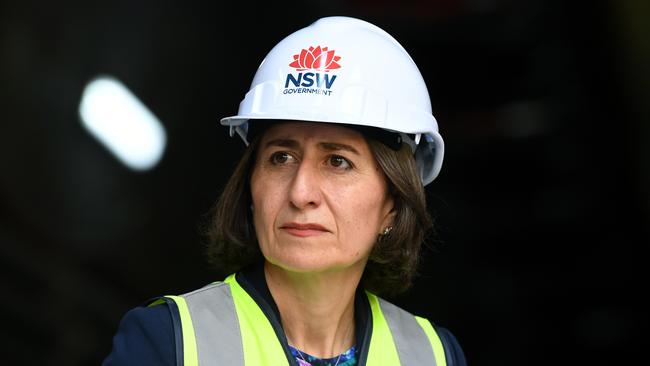
John Howard could be forgiven for thinking he is the Liberal Party’s patron saint of troubled political souls.
It has been another week and another state election campaign where the former prime minister’s image of stability, trust and strategic common sense has been used to bolster the chances of a modern Liberal leader fighting for their political life.
This week it was NSW Premier Gladys Berejiklian.
Rewind a few months and Howard was campaigning in Melbourne for the soon-to-be-former Victorian Liberal leader Matthew Guy and it is odds-on that he will be campaigning somewhere soon in Australia for Scott Morrison.
As Berejiklian struggles to stay afloat, it is an interesting question to ask whether a Howard government elected in 2019 could have been nearly as successful as it was in 1996 and beyond.
Whether the Twitter-fuelled, frenetic nature of contemporary politics, combined with the growing pains of higher population, super-sized house prices and employment uncertainty, would have allowed a federal leader to embark on an economically successful agenda that lasted for more than a decade.
Berejiklian, like every other government leader in Australia, is facing these modern speed humps.
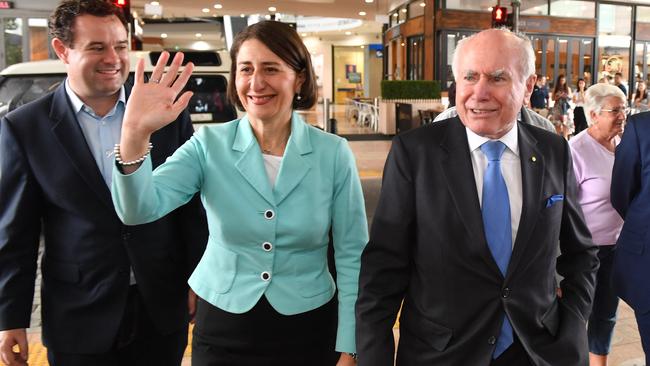
A political puzzle
It is a mark of the state of Australian politics that NSW is even having a debate about who will govern it after Saturday’s election.
The economy is the strongest in the country, it has surpluses averaging $1.3 billion, record low net debt and the government has promised and is delivering at its own pace on $90bn worth of desperately needed infrastructure.
Labor has a short-term leader elevated on the back of a predecessor’s sexual harassment scandal, and now Michael Daley is neck-deep in a racism bog over Asian immigration that may or may not derail his campaign. His frontbench team is largely untested and unknown.
David Gazard, a former adviser to Howard, Peter Costello and former NSW Liberal leader John Brogden, is genuinely shocked that Labor is in a lineball race with the Coalition.
“The government’s done a ton of big things. I am actually stunned they are in this position,” he told The Australian.
“You had a state, and particularly a city, crying out for infrastructure which has bedevilled governments for ages. The projects are happening, they are paid for and the state is in surplus.
“The money that has been raised out of poles and wires and other privatisations has been put back into infrastructure that people were crying out for.”
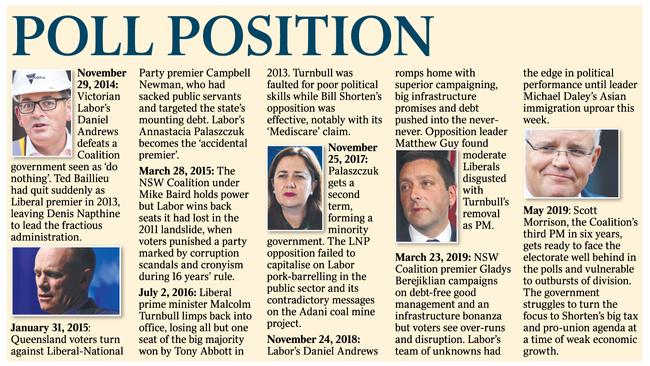
Gazard’s big question is whether the government has adequately sold its agenda to the electorate; that it’s one thing to do things, another to sell that agenda to the community.
Another question may be the extent to which voters are reluctant to embrace the NSW government following the federal leadership musical chairs and the general state of political melancholy that is gripping an outwardly wealthy nation.
Then there is the 2019 version of the voteless recovery.
How voters don’t necessarily reward governments for strong budgets, as Jeff Kennett discovered in 1999.
Consider also the effectiveness of the Labor machine, which is on the cusp of seizing office nationally and could be running the entire eastern seaboard by 8pm on Saturday if the votes fall their way in NSW.
State elections by nature differ from federal polls.
In the case of NSW, traditionally a Labor state, the impact of eight years of incumbency and how that feeds into the minds of voters should not be ignored.
Clumsy capital works
The Berejiklian government has its achievements but it is also weighed down by some significant baggage, including capital works overruns and some dysfunction of project delivery, the negatives of privatisation, the localised poison caused by the council amalgamations debate, the increasing rural-city divide, the greyhounds debacle, three Liberal leaders in two terms and the general dissatisfaction caused by the federal turmoil.
The latter was a major issue in Victoria last year.
While the NSW government has not been as divisive as the Kennett government in 1990s Victoria or the Newman government in Queensland between 2012 and 2015, it has introduced some of the reforms (those council amalgamations, for example, and privatisation) that proved deeply unpopular in both states.
It is no surprise that the Berejiklian government’s political mortality is tied closely to rural and regional NSW, fuelled by Labor’s strategy of linking infrastructure spending in the city with what on the ground ALP campaigners are saying is an indifference to the regions.
This dynamic is not new.
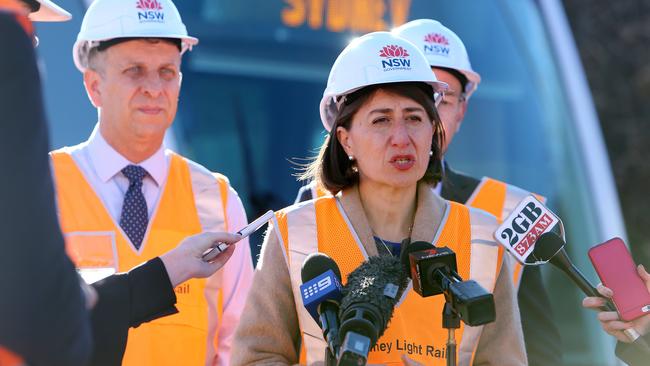
In 1999, Victorian Labor ran a brilliantly simple ad campaign accusing Kennett of failing the country.
The ad featured two taps, one titled Melbourne with water gushing out and another tap called country. It had no water.
“Jeff Kennett’s Office of Major Projects has committed more than $2bn to projects in Melbourne but outside Melbourne (zero). Jeff Kennett doesn’t care about the country,” it stated.
Labor’s Steve Bracks won office on the back of an anti-Kennett vote in the bush.
Like Berejiklian, Kennett went into the 1999 election overflowing with cash from power privatisations.
In some ways, Labor has exploited the debate about ANZ Stadium and Allianz Stadium as the equivalent of Bracks’s country-city taps.
Labor has told NSW country voters that the stadium budgets are symbolic of the way the Coalition had favoured city voters over the bush electorates.
The Irish model
Former West Australian premier Geoff Gallop, director of the University of Sydney’s graduate school of government, questions whether the NSW government has sufficiently engaged the community by explaining the merits of its agenda. This is particularly the case with major projects, which inevitably disrupt voters’ daily lives and can drive perceptions of efficiency or otherwise.
Gallop says the benchmark for community engagement was the manner in which Ireland overturned the Catholic daily double — abortion and same-sex marriage — through constitutional change.
He says the sophistication used to explain these reforms to the community was based on bringing people into the discussion.
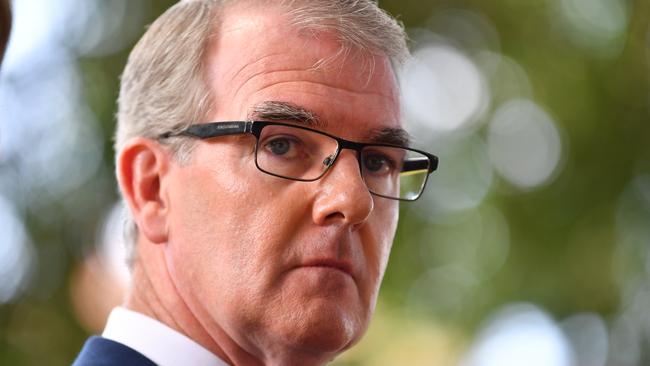
This has not happened with the NSW major projects agenda.
“They (the Irish reformers) properly engaged the people. And it has enormous authority because it is the people,” Gallop told The Australian.
The contrast between the NSW government and the Andrews government in Victoria seems to be stark.
While Victorian Labor profited greatly from the federal Coalition disunity in last November’s election, it also had capitalised on the dearth of major infrastructure projects under the previous Baillieu government.
Critically, it sold the merits of the projects to the community, particularly the multi-billion-dollar removal of dozens of congestion-creating railway crossings — a Melbourne-specific 19th and 20th-century anomaly that restricted capacity on the rail network and thwarted traffic.
Combined with an advertising blitz, voters were given direct evidence within one term that the state was on the move.
Hard to do business
Like NSW, Victoria is awash with transport projects but with an apparently heavier emphasis on explaining how to deal with the disruption.
A businessman recently told The Australian that the process of doing business with the Victorian government was simple. The reverse in NSW.
“Sydney is a hard joint to do business. Nothing happens easily,” he said.
When Campbell Newman won office in Queensland, there was a perception that he would take the state by the scruff of the neck.
In simplistic terms, the reverse happened, with the electorate picking him up and throwing him out after only three years.
Newman was swept into office and swept out with the next tide as voters rejected the lack of Liberal National Party consultation, particularly its swingeing cuts to the public service.
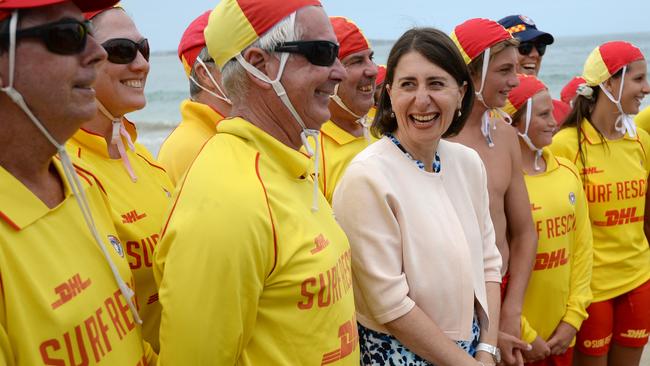
The commission of audit that led to 14,000 fewer public servants, scrapping same-sex, state-sanctioned civil ceremonies, and punch-ups with the judiciary and doctors helped seal his fate.
Gone was the biggest parliamentary majority in Australian political history and in came a green Labor premier in Annastacia Palaszczuk in 2015, who has run Queensland with mixed success ever since. She was re-elected in 2017.
The message of Palaszczuk and Bracks is that voters will elect people they don’t know well if they are given sufficient motivation.
Simon Banks, a former senior adviser to three federal Labor leaders, notes the impact of a big major projects agenda that is perceived as being mismanaged in terms of costs, deadlines and disruption.
“People in NSW are living with that as a normal part of their lives, whereas in Victoria the government down there pretty much delivered all of its major projects on time and budget,’’ he says.
Look local
Then there are the rural and regional seats, which seem likely to determine whether the Coalition can retain power, creating a complex environment in which scores of local issues will help decide the result.
Banks says: “That obviously makes the campaign far more complex, for example, than you might have seen in the Victorian election. This is clearly a battle for the hearts and minds of people right across NSW.”
It also opens up all sorts of questions for the conservative parties, with regional and rural Australia alive to the concept of political agitation.
Government defeat at the Orange and Wagga Wagga by-elections in NSW has accentuated Coalition concerns about a bush revolt, with the government going into the election with 52 seats in the 93-seat lower house.
The Berejiklian government would be forced into a minority government with the loss of six seats and a uniform swing of 3.2 per cent, while a majority Labor government would require 13 extra seats and a uniform swing of nearly 9 per cent.
This latter prediction would be one tall order, perhaps undermined by the NSW Labor leader’s gaffe on Asian immigration, with signs it could seriously damage the ALP’s last week of campaigning.
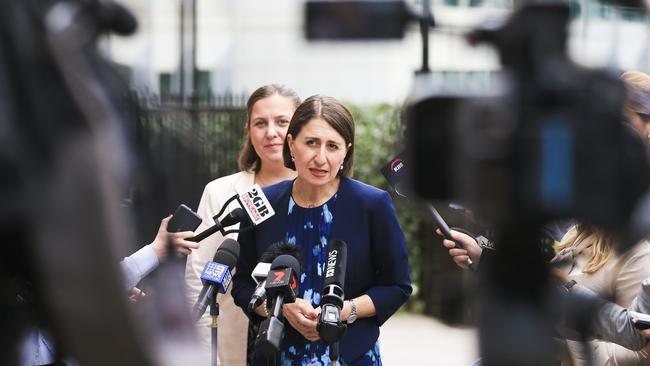
Howard, no stranger to the importance of the Asian vote in Bennelong, was wheeled out this week by the Coalition in outer-suburban Penrith, where he sledged Labor’s preference deal discussions with the Shooters, Fishers and Farmers Party.
The Liberals are claiming, somewhat cynically, that any preference relationship could lead to the watering down of the state’s/nation’s gun laws.
Howard, of course, has credibility on this issue, having introduced Australia’s new gun regime after 35 people were killed in the Port Arthur massacre in 1996.
Commenting on Daley and the spectre of the deal, Howard said: “I think it’s bad he’s made a preference deal because if Labor were to win with the help of the Shooters, the Shooters would demand relaxation of gun laws — as sure as night follows day.”
Guns, as evidenced by the Christchurch massacre, matter.
But so does the election result.
To that end, Howard appeared in a social media video for the Liberal Party denouncing any deal between the Shooters and Labor.
Dig a little deeper, though, and consider how much work the ALP has been doing in rural and regional NSW, not just to win seats for themselves but to help others disrupt the Coalition.
There is quite probably a shadow political world in rural and regional NSW that few know about but potentially will have a major impact on the result.
Labor desperately wants voters to believe Berejiklian has turned off the tap for country voters.
Even if she hasn’t.


To join the conversation, please log in. Don't have an account? Register
Join the conversation, you are commenting as Logout